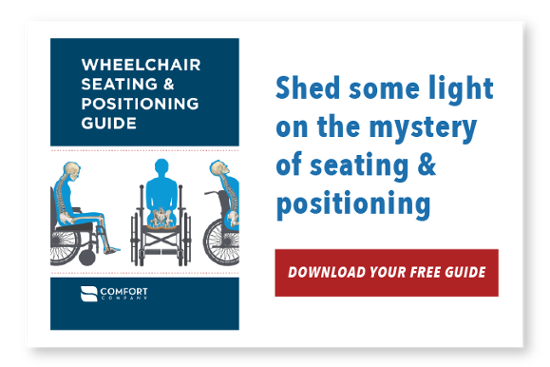Part 3 in our series about Progressive Neurological Disorders. See Part 1, Part 2.
What do you need to know?
Every progressive neurological diagnosis has its own hallmark, however most have signs and symptoms in common. By considering each of these and how they impact the seating system, you can select the best base and seating system for your client.
You should definitely discuss these signs and symptoms with your client when trying to explain the “why” when asked if they really need that fancy chair:
- Progressive weakness
- Sensation - hyper or hypo
- Decreased respiration
- Decreased ability to verbally communicate
In this blog I’m going to discuss progressive weakness and how to address it.
Progressive Weakness
Progressive weakness presents as:
- Tiring quickly in the seated position
- Decreased ability to move extremities
- Decreased ability to reposition self for comfort
- Decreased ability to perform pressure-relieving techniques
Our goal is to provide maximum independence and function. Sometimes this will mean promoting a more “normal” posture with a neutral pelvis and upright trunk. In other cases, your client may shift into what we consider an abnormal posture. However, that abnormal posture is what provides them with the stability to be able to use their extremities.
A good example of this is the common posture of children with muscular dystrophy: anterior pelvic tilt with excessive lordosis. Under normal circumstances a therapist would try to minimize the time a child spends in this posture. But in this case, it is EXACTLY what a child with muscular dystrophy needs to gain function. Through that posture, they essentially are stacking their pelvis for proximal stability, which allows them to use their upper extremities. By trying to change this posture into a more neutral position, you may take away their function. Always consider posture along with function as you address progressive weakness in a seating system. Maintaining independence and function in spite of physical changes is the goal of the seating system.
How can we address progressive weakness with the seating system?
1. Choose a base with power seating functions (tilt, recline, power leg rests) that will allow for changing positions during the day. This will in turn:
- Reduce pain
- Improve circulation
- Decrease risk of edema
- Minimize loss of range of motion
- Provide skin protection at bony prominences
2. Choose adjustable seating system components. Over time, weakness in the trunk and/or pelvis significantly impacts their ability to stay in the chair for hours at a time. Adjustable seating components allow a range of modifications and adaptations such as:
- A cushion adjusted to stabilize the pelvis
- A cushion adjusted to provide comfort and minimize pain with changing posture
- A cushion adjusted to increase skin protection with changing posture
- A back support adjusted to maintain natural curves of the spine that flatten with weakness
- The ability to add lateral trunk and thigh supports to promote neutral posture for optimal function
- An adjustable head support to accommodate changes in head position with weakness
3. Choose upgraded electronics that support a variety of driving methods. With the appropriate electronics your client can:
- Drive independently using switches, head controls, foot controls or a combination of these
- Reposition themselves for comfort and perform pressure relief independently
- Access their personal devices independently
Remember, it’s all about providing our clients with the highest quality of life as they lose function. Stay tuned for my next blog where I’ll address considerations for sensation, respiration, and communication issues.

Stacey Mullis, OTR/ATP
Director of Clinical Marketing
Stacey is Director of Clinical Marketing. She graduated from Western University in London, Ontario, Canada with a BA Linguistics and BSc Occupational Therapy and has practiced as an OTR for over 20 years. With experience in pediatrics, inpatient/outpatient rehabilitation, long term care, and home health, Stacey has faced the challenges first hand of providing appropriate seating in various clinical settings. This led her to pursue an apprenticeship at Care Partners Seating Clinic in Asheville, NC to advance her skills, and she obtained her ATP certification in 2012. Mullis is a member of the NCOTA, CTF, NRRTs, RESNA, and AOTA.

